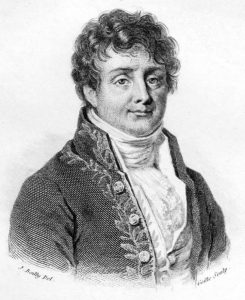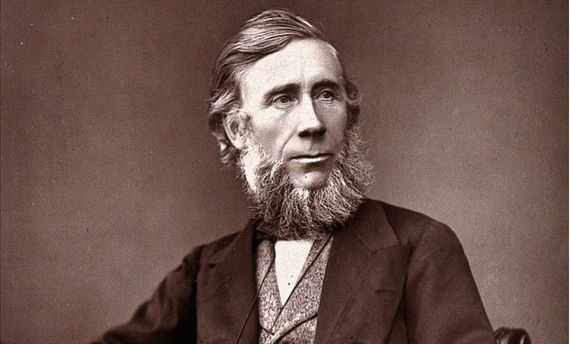Extreme weather events are now more frequent and severe than ever before. Floods, fires and heat waves receive a lot of attention in the media, and climate scientists are starting to make increasingly more direct public statements about the risks to society. But the science behind what we are now seeing has been known for 200 years. Would you like to know who discovered climate change and how?
1807 – Joseph Fourier
Jean-Baptiste Joseph Fourier (March 21, 1768 – May 16, 1830) studied with great mathematicians like Lagrange and Laplace at the École normale supérieure and was a professor at the Polytechnic University of Paris. Fourier considered “nature the most important source of mathematical discoveries” and in 1807 published his first mémoire, On The Propagation of Heat in Solids, in which he formulated the heat equation.

He was so fascinated by these equations that govern the transfer of heat that he decided to calculate the amount of solar energy that reaches our planet. The result was unexpected. His calculations showed that the Earth should be much colder than it was. Something in the atmosphere was preventing heat from escaping. But what could it be? He never managed to find the answer.
1856 – Eunice Newton Foote
Three decades passed until another scientist, Eunice Newton Foote, (July 17, 1819 – September 30, 1888), a pioneer of women’s rights, was intrigued by the possibility that the atmosphere could be trapping heat.

In her brief study entitled Circumstances Affecting the Heat of the Sun’s Rays, she described an experiment in which she exposed glass cylinders to the sun, equipped with thermometers and attached to a pump to extract the air from one of them and compress it in the other. Therefore, Eunice was comparing the heat in both cylinders. She observed firstly that the container with the compressed air became hotter than the one in which there was a vacuum. Secondly, that the heat was greater with humid air than dry air. Thirdly, and this was her great, almost fortuitous finding, as she also tested with hydrogen and oxygen, that the higher degree of heat took place when filling one of the cylinders with carbonic acid (CO2). “The receiver containing the gas became itself much heated—very sensibly more so than the other—and on being removed, it was many times as long in cooling,” she wrote.
1861 – John Tyndall
Three years later, climate science focused its attention on the Irish scientist John Tyndall, (August 2, 1820 – December 4, 1893), one of those rare scientists whose name pops up unexpectedly in a thread of such disparate subjects that one asks themselves if it is the same person. He determined that carbon gas, a mix of methane and other gases heavily absorb infrared radiation.

Tydall shared the scientific concerns of his time, and thought that changes in the atmosphere had caused the ice ages. To investigate, he designed precision equipment and tested different gases. Just like Foote, Tyndall discovered that CO2 retained the greatest amount of heat – exactly 1,000 times more heat than dry air. He was concerned by the consequences of small increases in the amounts of CO2. But this did not bother others. Methane was later detected in the atmosphere in 1948 and in the 1980s, scientists realized that human emissions had a substantial impact.
1895 – Svante Arrhenius
The Swedish mathematician Svante Arrhenius (February 19, 1859 – October 2, 1927), the first Swede to receive a Nobel Prize in 1903, ended up studying the findings of Fournier and Tyndall. In 1895, Arrhenius wanted to quantify this influence on the greenhouse effect, which entailed doing endless, complex and tedious calculations which apparently served as a form of therapy to overcome his separation from his first wife. The results obtained finally saw the light of day in an article published in 1896. In it, he concluded that reducing CO2 levels in the atmosphere to half the amount that existed at the time would decrease the temperature of the planet between 4ºC and 5ºC. This could lead to a cooling as massive as that which takes place during glaciations.
In the 1960s, ecological modernism was born thanks to Rachel Carson, and in the 1970s, scientists’ opinion was increasingly in favor of points of view on warming. In the 1990s, as a result of improvements in the reliability of computer models and observational work that confirmed the Milankovitch theory of ice ages, a consensus was reached that the greenhouse effect was involved in most climatic changes and that human emissions were leading to serious problems in global warming. Since then, most scientific work has been geared toward producing reports for the Intergovernmental Panel on Climate Change.
Without a doubt, climate change is one of the most pressing problems of our time. It is with good reason that the World Economic Forum considers climate inaction a more destructive threat to humanity than the use of weapons of mass destruction. But it cannot be understood or treated as an isolated crisis. Climate change is a vector that accelerates and is accelerated by numerous environmental problems: loss of biodiversity and ecosystems, pollution, resource crises, etc. They are all deeply interconnected. Wanting to solve one entails solving all of them. To talk about climate change is to fail to recognize the five million deaths the environmental crisis caused in total back in 2010.
As a result, we have reason to be concerned. Because even if it doesn’t matter when climate change was discovered, we know that it has been clear for a long time, even if many deny it.
Paz Palacios
Comments on this publication